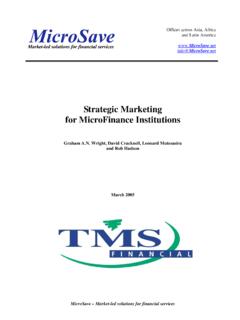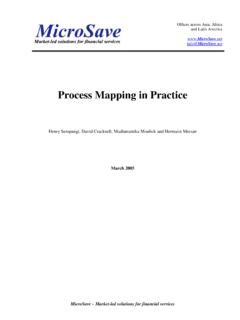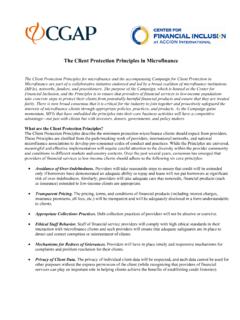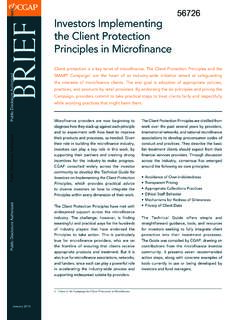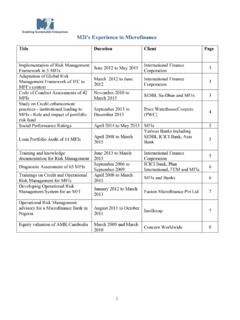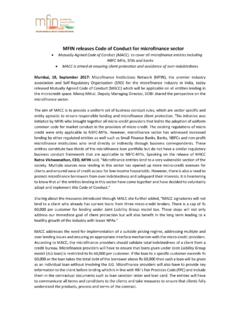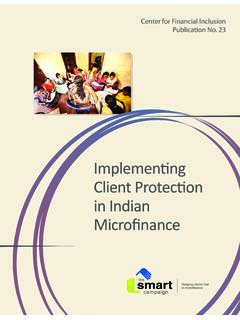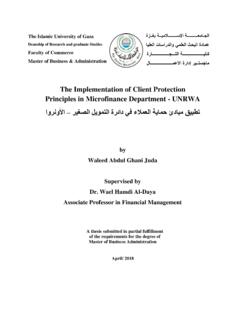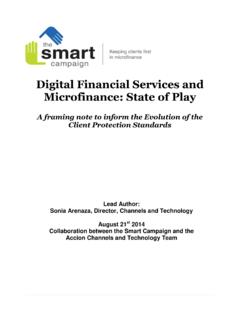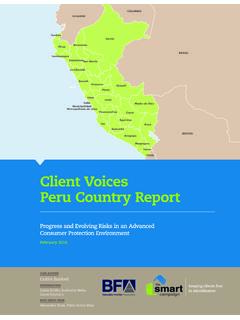Transcription of MicroSave Briefing Note # 127
1 1 La Prensaa, December 20, 2010 2 National Deposit Insurance Corporation, Nigeria, Press Release 3 The Economic Times, June 29, 2012. Also, see MicroSave s India Focus Note 55 The Andhra Pradesh Crisis: Three Dress Rehearsals .. and then the Full Drama and 57 The Andhra Pradesh Crisis: What Should MFIs Do? 4 2011 Asia Regional Snapshot , Mix Market 5It is a quantitative tool that assesses the performance of financial institutions in implementing CPPs and provides relative rankings of the seven CPPs. 6 The research was conducted with 357 clients of seven MFIs. Offices across Asia, Africa and Latin America Reach us through and MicroSave Briefing Note # 127 clients protection - Lessons for the microfinance Sector Amit Garg and Anirban Roy July 2012 The microfinance sector can be a powerful poverty alleviation tool.
2 However, recent events have raised concerns about the intent of microfinance , resulting in huge losses to the sector. In Nicaraguan, the No Pago movement caused a drop of 23% in the microcredit portfolio and denied access to credit to over 100,000 clients in the In Nigeria, the Central Bank revoked the operating licenses of 224 microfinance banks for not catering to the intended client In India, high indebtedness among clients and alleged multiple suicides by borrowers due to coercive recovery practices prompted Andhra Pradesh to enforce restrictive microfinance regulations that resulted in mass defaults.
3 SKS microfinance alone wrote off nearly Rs 1,500 crore in loans, among many These are strong indications for the sector to introspect on how well is the microfinance sector protecting its clients , and in turn protecting itself? This Note tries to answer this question by explaining how clients perceive client protection and what the stakeholders can do to fulfil clients expectations for protection on financial matters. Background To The Research microfinance borrowers in South Asia increased from 30 million in 2005 to 60 million in 2010,4 so did the associated risks. According to the Banana Skin 2011 report, reputation risk rose to position 2 from position 17 in two years, making client protection even more important.
4 However, client protection measures generally do not take into account clients own priorities, which are likely to vary between regions and markets. In 2008, The Smart Campaign developed seven client protection principles (CPPs), which have been endorsed by 700 MFIs worldwide. These principles advocate design and delivery of financial services for the poor in a responsible manner by protecting clients from malpractices. MicroSave developed a ServQual tool5 to assess the performance of MFIs implementing CPPs. Briefing Note 125 explained the evolution and development process of the tool. Briefing Note 126 explained the design of and pre-requisites for using the tool.
5 This Note presents the summary of the research with microfinance clients in Bangladesh, India, and the Importance of client protection principles The research suggests that clients consider all seven principles to be valuable. However, when asked to rank them in their relative importance, clients had clear preferences. The perception of protection also varies across geographies. Chart 1 below compares the relative rankings of the CPPs in India and the Philippines. Chart 1: Relative Ranking of client protection Principles Source: client protection Research, MicroSave clients ranked fair and respectful treatment as the most important aspect, followed by transparency.
6 Respectful Behaviour on the part of MFI officials encourages clients to form a relationship with the organisation, and this increases their satisfaction with the MFI. In the Philippines, clients describe the effect of this principle as something that enables them to better express themselves, feel heard and responded to, which develops trust to work with the MFI. Transparency is the second most important principle. clients believe that clear information helps them take better and more informed decisions. In India, socio-cultural norms mean that many female clients expressed the need to explain product terms to their husbands to get the family approval before taking the credit.
7 Irrespective of location, clients believe that it is the moral responsibility of the MFI to prevent the over indebtedness by checking the repayment capacity of clients . Appropriate product design is considered more important in India than in the Philippines. In India, due to unavailability of savings and insurance services, this principle was ranked two points higher. client protection PrinciplesThe PhilippinesIndia Fair and Respectful Treatment of Clients11 Transparency22 Prevention of Over-indebtedness34 Responsible Pricing45 Appropriate Product Design and Delivery53 Privacy of Client Data67 Mechanisms for Complaint Resolution76 If they respect me, I respect them too.
8 I show my respect by cooperating with the MFI and doing everything to meet my repayment obligations. 7 Given all MFIs scored above , to clearly show the difference, the graph plots scores between 2 and 3. 8 See MicroSave s India Focus Note 74 Relevance of Customer Service Post the Andhra Crisis Offices across Asia, Africa and Latin America Reach us through and clients expressed the willingness to pay higher than formal banking charges as long as MFIs behave well and finance is available on a timely basis. clients view responsible pricing as: 1) knowing the charges involved and having agreed to them; 2) low enough interest rate to allow them to pay it easily; and 3) interest is paid on any form of compulsory savings or collateral taken by MFIs.
9 clients equate trust to the MFI s capacity to keep their data confidential. Loan size and repayment record are the two key data sets that should be protected according to clients . In India, most clients have a hazy understanding of privacy issues and how their data can be used by the MFI. But they expressed comfort in sharing their details with credit bureaus. Less than 5% clients had any complaint against the staff of MFIs. They preferred to solve issues within their social groups, but they also emphasised the need for a formal complaint resolution mechanism that goes beyond the group leader and the field officer. Performance Rating Of Servicing MFIs On Implementing client protection Principles clients were asked to rate their MFIs performance in implementing CPPs on a scale of 1 to 3; 1 being poor and 3 being excellent.
10 After rating the performance, they were asked to rank the principles in the order of importance of each principle for them. In all three countries, clients have given high ratings to organisations on all principles. On a scale of 3, all MFIs scored more than With an average score of , the Bangladesh MFI scored highest, followed by India ( ) and the Philippines ( ). The chart 2 below summarises the responses and present a comparison of the three country Chart 2: Country Comparison of MFIs in Implementing CPPs Source: client protection Research, MicroSave In Bangladesh, clients rated the MFI high on transparency and mechanisms for complaint resolution.
